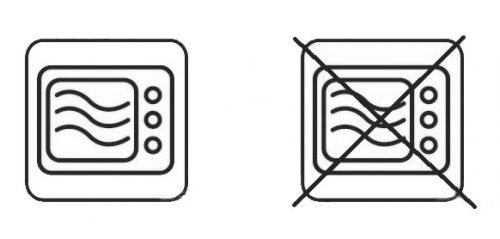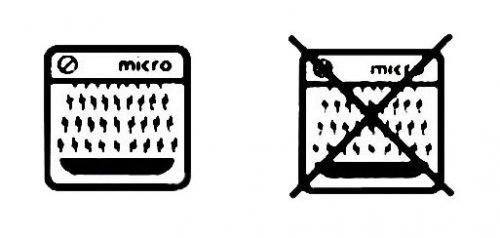Plastic dishes can be cooled to -40 ° C and heated to +140 ° C. Plastic dishes have lids. They attract with their versatility: they are suitable for freezers and microwave ovens.
Marking of plastic tableware
You need to be very careful here. Not every plastic is suitable for use in a microwave oven. Be sure to check that there is a special marking on the container bottom: an icon with a schematic image of the microwave oven. The plastic must withstand heating to 130-140 ° C.
Microwave safe – you can make and heat food in it
There are also such signs:
Not recommended for microwave or recommended for microwave
A crossed sign indicates that it is not suitable for microwave.
If a dish doesn’t contain a sign with microwave oven, but contains such sign:
Such dishes are intended for heating in a microwave.
Be careful if a dish contains such sign:
It can not be used in a microwave oven. Moreover, it is not even suitable for hot drinks and food. These containers are only used for cold food. Or as a transfer for sandwiches.
It is absolutely unacceptable to put plastic dish without this sign in a microwave oven. And it’s not even that a plastic container can simply deform or melt during cooking. When heated, poor-quality plastic begins to decompose with the formation of harmful substances that enter the atmosphere and dissolve in the food that is in the dishes.
You can rely on only proven, well-known brands, bought in a store, capable of presenting quality certificates.
For use in the microwave oven, polyamide and polypropylene plastic are allowed. Polystyrene and PVC (PVC) are absolutely unacceptable,, polyethylene should be treated cautiously.
A few more points about polymers in the microwave:
- If you have a grill function, it is better not to use plastic.
- If you want not just to warm up, but to prepare a dish, then plastic is not suitable for making dishes using sugar and fat. These components easily heat up to temperatures at which the plastic starts to deform and melt
You should avoid placing polyethylene into the oven. A thin polyethylene film will simply melt away from a temperature increase, and a thick one can begin to spread the unpleasant odor that will spoil your products.



